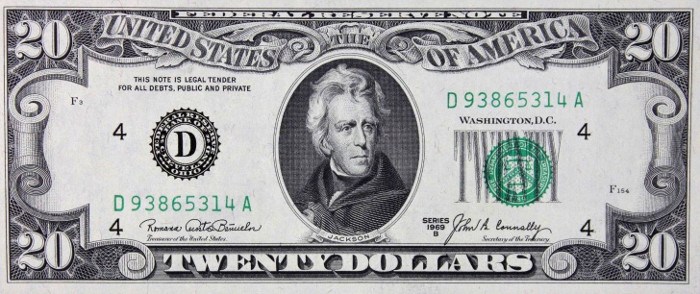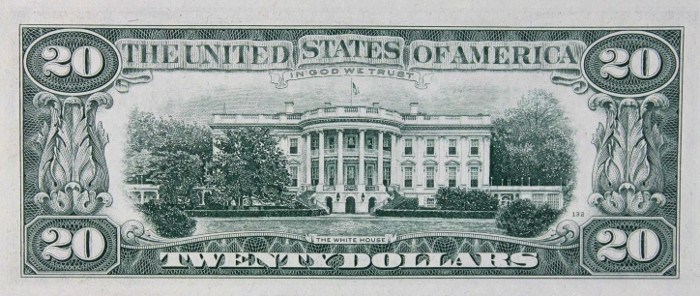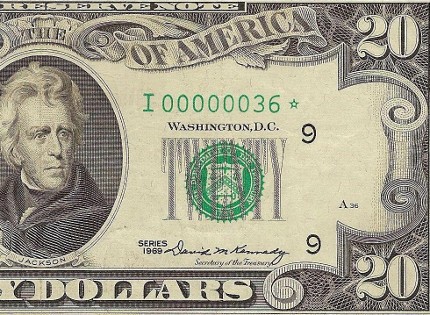The 1969 20 Dollar Bill has value, mainly because it's an old bill that is no longer in circulation. 1969 was also the first year that the new treasury seal appeared on the 20. If your bill is in lightly circulated condition then it's going to be worth more than its face value of $20.
You rarely ever see an old $20 bill design anymore because the government has taken them out of circulation. The average lifespan for any US 20 dollar bill is only around 7 years. Whenever a bill gets old or worn out the government takes it out of circulation. Also the modern 20 dollar bills have additional security features that helps prevent counterfeits.


Specifications
| Denomination: | $20.00 U.S. Dollar |
| Type: | Federal Reserve Note |
| Seal Varities: | One: Green |
| Series: | Four: 1969, 1969A, 1969B, and 1969C |
| Issuing Banks: | 12: Atlanta, Boston, Chicago, Cleveland, Dallas, Kansas City, Minneapolis, New York, Philadelphia, Richmond, San Francisco, St. Louis |
Value
The value of your bill will depend on a variety of different factors. The main factors are the series and the condition. These bills aren't too old, so most bills in circulated condition will only be worth their face value of $20. Collectors are only interested in 1969 twenty dollar bills that are in very fine condition and up. See our grading guide at the end of this article for reference.
The 1969 series $20 bills are worth around $30 in extremely fine condition. In uncirculated condition the price is around $52.50-60 for bills with an MS 63 grade.
The 1969A series $20 bills are worth around $35 in extremely fine condition. In uncirculated condition the price is around $70-85 for bills with an MS 63 grade.
The 1969B series $20 bills are generally more valuable. Each note is worth around $40-50 in very fine condition. In extremely fine condition the price is around $70-125. In uncirculated condition the price is around $200-250 for bills with an MS 63 grade. Bills issued from the Federal Reserve Bank of St. Louis will be more valuable.
Lastly the 1969C series $20 bills are worth around $25 in extremely fine condition. In uncirculated condition the price is around $50-65 for bills with an MS 63 grade.
Star Notes
If your bill has a star before or after the serial number then it's going to be more valuable. It's easy to see if you have a star note: Check the serial number. If you see a star instead of block letter at the end of the serial number then congratulations, your bill is more valuable. Check out the image below for an example. These star notes are essentially replacement notes for damaged or misprinted currency, which makes them more rare.

Most 1969 series $20 star notes are worth around $45 in very fine condition. In extremely fine condition the value is around $65. In uncirculated condition the price is around $125-175 for bills with an MS 63 grade.
The 1969A series $20 star notes are worth around $50-65 in very fine condition. In extremely fine condition the value is around $70-75. In uncirculated condition the price is around $100-145 for bills with an MS 63 grade.
The 1969B series $20 star notes are worth around $80-90 in very fine condition. In extremely fine condition the value is around $175-225. In uncirculated condition the price is around $325-350 for bills with an MS 63 grade. Bills issued from the Federal Reserve Banks of Kansas City and San Francisco will be more valuable.
Lastly the 1969C series $20 star notes are worth around $55 in very fine condition. In extremely fine condition the value is around $80. In uncirculated condition the price is around $165-170 for bills with an MS 63 grade.
Factors That Affect the Value
Below are some factors that can affect the price of your bill, either positively or negatively.
Condition
When determining value, the first aspect to consider is a bill's condition. The better the condition, the higher the value.
So how do you judge condition?
There is a univeral grading system that all dealers and collectors follow. Read below to learn about some of the specific grades.
Grading System
Very fine- A note that has been in circulation but not for a long time. The note is still relatively crisp. There may be some creases, folds, or light smudges.
Extremely fine- A note that shows small signs of having been in circulation. The note will be bright and it will have almost all of its original crispness. There might be one or two minor creases or folds but there are no stains, discolorations, or tears.
MS 63 choice uncirculated- A note that shows no signs of ever having been in circulation. The note still has its original crispness. The note is also well-centered.
Note: If you think your bill is in uncirculated condition then you should consider having it graded. A currency note with a high grade is worth more money.
Special Serial Numbers
Does your bill have a unique serial number? If so then it's going to be worth more money. Here are some serial number types to look for:
Low Serial Numbers
A low serial number indicates that it's one of the first bills to ever be printed in a series. An example would be A00000001A.
High Serial Numbers
A high serial number can be quite rare because typically the mint would just change to a new series rather than continuing to print the current series. An example would be F99999995G.
Birthday Serial Numbers
Some collectors look for serial numbers with their exact birthday. The market for these numbers is more limited, but it only takes one person to pay a lot of money for a birthday serial number. An example would be B01251985F. This serial number would equate to the date of January 25th, 1985.
Uncommon Serial Numbers
Any serial number with an uncommon sequence has value. Some examples are ascending or descending sequences such as B12345678C or B87654321C. Another example is a block of solid numbers such as C55555555A. These uncommon sequences are very rare, so it's good to keep an eye out for them because of their value.
Note: You can use our fancy serial number checker to see if your serial number has any interesting properties.
Conclusion
This is definitely a nice bill to own. If you have a valuable bill then you should consider putting it into a currency holder to keep it safe.
If you plan to buy one of these bills then make sure to buy from a reputable currency dealer. Remember that any valuable old currency will also be faked.
Sources:
A Guide Book of United States Paper Money
See also:
